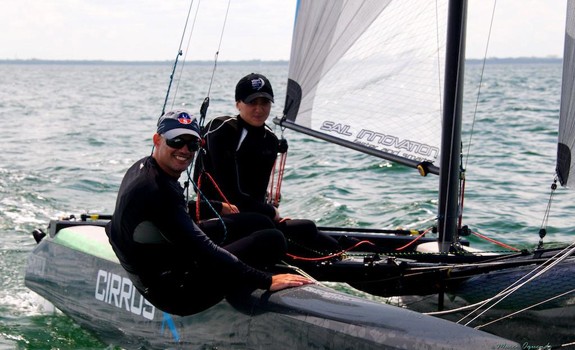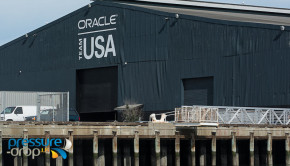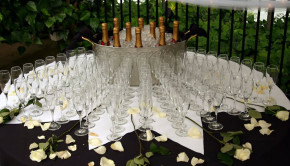Sarah Newberry: Primed to take the next step
Published on January 21st, 2013
 The pendulum has swung back. Interest in multihull sailing is on the rise. Heck, even ISAF decided a new catamaran design – the Nacra 17 – was Olympic worthy. So for the next four years, the race is on to see who can become the very best by the 2016 Games.
The pendulum has swung back. Interest in multihull sailing is on the rise. Heck, even ISAF decided a new catamaran design – the Nacra 17 – was Olympic worthy. So for the next four years, the race is on to see who can become the very best by the 2016 Games.
A leading contender is the team of Sarah Newberry (24) and John Casey (38). Both have made their mark in the U.S. multihull scene and are primed to take this next step. With the ISAF Sailing World Cup Miami next week, Scuttlebutt checked in with Sarah regarding their campaign:
1. What has, up to this point in your sailing, given you the confidence to take this step?
I think that the Olympic path is one I have always wanted to be on. I spent a long time trying to understand the way a campaign works from the outside, and asking questions because I was too shy to take action instead. A lot of experienced friends, like Jay and Pease Glaser, were very patient about this.
Then, after sailing very well for several days at the 2011 US Multihull Championship, I lost first place in the event because I was unprepared. I had only practiced once or twice in six months, and honestly, I didn’t even really understand how to sail the F16 Viper. I learned what lack of discipline and dedication could feel like, and it shocked me into changing the way I looked at sailing – I decided to re-approach my sport. I realized I had to treat myself like a real athlete or I would never be happy racing.
Last fall I gave a presentation which was livestreamed to a global audience. I shared how my passion for the sport had grown over time, and how it had led me to decide to pursue a path to the 2016 Games. Having to announce this goal to folks around the world was a pretty big step. Saying it out loud really directed my approach.
When the Nacra 17 was announced this past spring as the multihull for the Games, I made the phone call and put my name on the list to purchase a boat. Afterward, in a panic, I called my mother and said: “Mom, I think I just did something really crazy.” I wasn’t sure how I was going to accomplish it, but I knew committing to the boat was the next step and that my conviction was really all I needed to make everything work out.
So the answer is: it wasn’t so much the confidence as much as blind determination that has gotten me this far. Now I have started to develop the kind of true confidence that one needs to keep taking intelligent steps forward.
2. Has the uncertainty of multihulls in the Olympics since 2008 had any impact on how you approach sailing?
This is a great question. I think it really has impacted the way I approached the idea of becoming involved in Olympic sailing. I certainly do not take for granted the fact that the multihull has representation now, and I feel that ensuring that it continues to be represented is a responsibility that we share as racers and enthusiasts.
Multihull sailors know what it feels like to not have an Olympic path. The uncertainty, at least in my case, has created quite a sense of urgency to participate – and especially a sense of urgency to participate in a way that can help to develop multihull sailing from the ground up in the United States. I don’t want to see the path disappear again. I think it’s lent me a very community-oriented sensibility. I want to share my experiences and processes to help raise the level and build the sport.
3. When ISAF selected the Nacra 17, they did so based on a new prototype. Now that production has begun, how are the boats getting distributed?
There are ten boats coming to North America in the first container. Six of them are going to U.S. teams, and the others belong to teams who chose to have their boats shipped here. The boats arrived in time for us to begin training last week, and we are looking forward to competing next week in the ISAF World Cup Miami. More boats will come for U.S. teams late next spring as well.
4. This is a mixed event. Does the Nacra 17 lend itself to a specific skipper/crew combo?
I don’t think it’s fair to say yet. We know that in our case the female skipper and male crew combination is the way to go, and while in many cases we think this will turn out to be a strong approach, we really don’t believe that we can speak for other teams.
As far as our campaign is concerned it’s very simple. I am a bad crew. Not because I’m bad at crewing, but simply because compared to John it takes me years to hoist the spinnaker. So my abilities are limited and I know it. As a fantastic skipper, John Casey could easily take on either role – but would need a strong lady on the bow to pull strings.
As you can tell, we’re playing on our strengths as a team and not just as individual sailors. I can’t wait to see some serious female crews take on the guys at top mark roundings though!
5. How did you and John get connected? What do you see as each of your attributes that will make this a good team?

I feel very fortunate to be teamed up with John. We’ve known each other a long time even though we had never sailed together. When I was fifteen and puttering around the race course on a Hobie 16 I was idolizing guys like John Casey who were out there racing Nacra 20s and F18s up the coast in the Worrell 1000 and the Tybee 500.
Our situation just sort of unfolded. We were both hoping to put together a strong campaign, and I had even tested the waters a bit with some fantastic crews. By the end of this summer, the idea of sailing together was introduced to us by some mutual friends in the multihull racing world. John has always really been a skipper, and one of the best in the country. So when he offered to crew for me I was pretty floored.
After a few practice days to feel things out we had realized that not only was the skill level there, but we also seemed to genuinely get along. That was a big plus. John fell into the crew position so easily it’s almost frightening – I think when you sail a performance multihull with a 115 pound girl, the crew position is especially challenging at first because it requires so much communication to get everything flowing. It’s a big transition to make.
Moving forward there are a few things that I think will be the standout attributes. John comes on board as a highly experienced helm, and a very good coach. I am learning so much from him. His experience also makes him a very patient crew, and the ability to stay calm and reason things out on the boat is something that we share. I like to think that what I bring to the table is good communication skills and a natural feel for the helm. I’ve sailed a lot of boats with a lot of different partners. What we both know is that being a successful mixed-gender team is hard. We’re totally on top of that idea. Good communication is something that keeps any business running or any relationship strong and so it’s one of our biggest goals as a team.
Finally, while we know that there are going to be difficult moments along the way we share an incredible dedication to our practice as athletes and sailors. This is something that makes me so excited about our partnership.
6. The US Olympic review report would like to see training opportunities improve stateside to reduce the cost of European training. How much can you accomplish in the U.S. and what needs would pull you out of the country?
So much can be accomplished here in the U.S. There is an incredible amount of talent in U.S. multihull sailing right now. We have a community-oriented training approach, and we know that there will be a lot of value in staying in North America for training.
With that said, most of the racing we do will happen in Europe. So we are trying to stay very smart about selecting which events to sail abroad. We are choosing the events that fit our plans as a group – and we are really looking forward to being able to show what we can do as a U.S. team in the next year. For now we know that we’ll be spending quite a bit of time prepping for the Nacra 17 World Championship in Holland in the summer. Most likely you’ll see us in Europe for little while beforehand at least. And as we move forward we’ll be sharing information on our campaign and the group training on our blog. Keep your eyes peeled. Good things are happening for U.S. multihull sailing!
You can follow Sarah and John at…
Website and blog: www.usamultihull2016.com
Facebook: www.facebook.com/newberrycasey2016
Twitter: www.twitter.com/sailrio16











 We’ll keep your information safe.
We’ll keep your information safe.